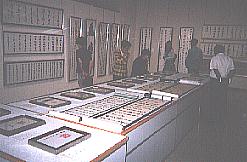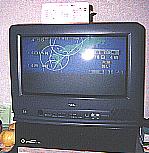| Extended workdays and long commutes leave the Japanese chronically sleep deprived. As a people, they must have the shortest sleep latency in the world. Put them on a bus or train and they'll fall asleep within minutes (but they'll somehow always manage to wake up before their stop)! |

Fukuoka is on the northern end of Kyushu and is the island's biggest city.
In some ways it looks like Toronto, with a skyline that stretches along the waterfront and
features a tower and a stadium with a retractible roof,
the Fukuokadome.
We checked into the Green Hotel, right next to the main train station. It's what the Japanese call a "business hotel". At about Y6500 per night for a single room, there's probably no cheaper or more convenient accommodation. It's small and it's not luxurious, but the essentials are there: comfortable bed, shower that doubles as a furo (bath), television and...green tea machine!
Blue button = mizu (cold water); red button = oyu (hot water);
green button = ocha (green tea)!
 The weather was holding up but threatening,
so we decided to go out, but to someplace indoors.
At the Art Gallery,
the prefectural shodo (calligraphy) society was putting on an exhibit.
This was the first time I had seen so much calligraphy in one place.
I was impressed with the many unique styles and presentations.
I couldn't read any of the scrolls and hangings, though everything was so
stylized that I doubt if knowing kanji would have helped!
As an art form, it seems to have broad appeal in Japan --
among those attending the show were seniors, middle-aged ladies as well as young couples.
It was Keiro no hi (Respect for the Aged Day), a
national holiday, so all kinds of people were out.
The weather was holding up but threatening,
so we decided to go out, but to someplace indoors.
At the Art Gallery,
the prefectural shodo (calligraphy) society was putting on an exhibit.
This was the first time I had seen so much calligraphy in one place.
I was impressed with the many unique styles and presentations.
I couldn't read any of the scrolls and hangings, though everything was so
stylized that I doubt if knowing kanji would have helped!
As an art form, it seems to have broad appeal in Japan --
among those attending the show were seniors, middle-aged ladies as well as young couples.
It was Keiro no hi (Respect for the Aged Day), a
national holiday, so all kinds of people were out.
 My father had to catch a plane for Tokyo in the morning, so we settled in for
a typhoon watch. The weather channel had hourly updates on the typhoon's
progress, and chanted a mantra of
"Oo-ame (heavy rain), taka-nami (high waves), bofu (stormy weather)" in between.
By 3 a.m. it appeared that the typhoon would reach Fukuoka close to my father's takeoff time,
so he decided to leave on the first Shinkansen (bullet train) instead.
My father had to catch a plane for Tokyo in the morning, so we settled in for
a typhoon watch. The weather channel had hourly updates on the typhoon's
progress, and chanted a mantra of
"Oo-ame (heavy rain), taka-nami (high waves), bofu (stormy weather)" in between.
By 3 a.m. it appeared that the typhoon would reach Fukuoka close to my father's takeoff time,
so he decided to leave on the first Shinkansen (bullet train) instead.
Televisions in Japan are now more rectangular, like a movie screen.
 Left to my own devices for a day before my Japan Rail Pass became valid,
I took a half-day city bus tour of Fukuoka. There were only seven other
people who braved the rapidly deteriorating weather to see an obi
weaving workshop, the ruins of a Buddhist temple, and the famous
Dazaifu
Shinto
shrine (at left). The wind was growing stronger,
but our guide didn't miss a beat, even though her hat and
her little flag nearly blew away! We put on a calm face for the obligatory
kinen shashin (commemorative group photo) as raindrops started to fall.
Left to my own devices for a day before my Japan Rail Pass became valid,
I took a half-day city bus tour of Fukuoka. There were only seven other
people who braved the rapidly deteriorating weather to see an obi
weaving workshop, the ruins of a Buddhist temple, and the famous
Dazaifu
Shinto
shrine (at left). The wind was growing stronger,
but our guide didn't miss a beat, even though her hat and
her little flag nearly blew away! We put on a calm face for the obligatory
kinen shashin (commemorative group photo) as raindrops started to fall.
|
Fukuoka obi (sashes worn with kimono) are noted for their quality.
Purchasing one as a gift can be difficult, though -- there are many colours and styles,
some more appropriate for certain ages than others. The obi should
also complement the kimono. Then there's personal taste to consider.
It's a bit like buying a necktie!
|
I was safely back in the hotel by the time the typhoon hit in the afternoon (a bit later than predicted). Heavy rain pelted against the window for a few hours while I watched sumo on TV.
By evening, the typhoon had passed. As is usual after a typhoon, the weather was calm. My cousin Hiroaki met me for supper. His hometown is Kumamoto, about 70 km away, but he works in Fukuoka now for a business magazine, writing profiles of various companies. No two companies are the same, so it's an interesting job, he says.
Hiro-kun took me to Clio Court, a restaurant close to the train station. It is a modern concrete building on the outside, but step through the noren (shop curtain) and you're transported back in time: The interior is dark and made of wood, the waitresses are clad in kimono, and wind chimes ring softly. The food was excellent -- we had a number of small traditional and exotic dishes, like Japanese tapas!
|
Local Food
Hakata ramen - round noodles in an almost creamy, whitish soup. Mentaiko - fine fish roe with varying amounts of hot spice. Great with spaghetti! (More information and recipies [J]) |
